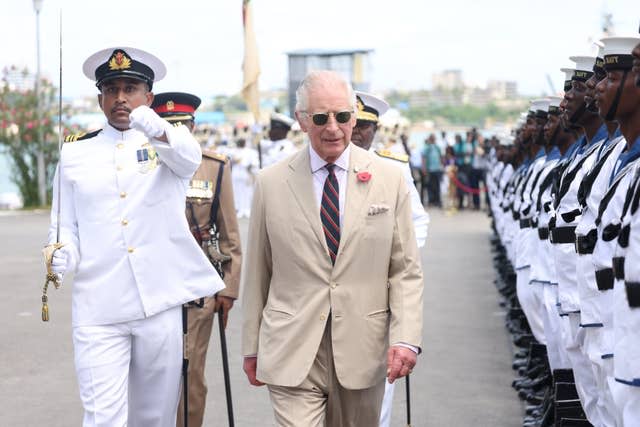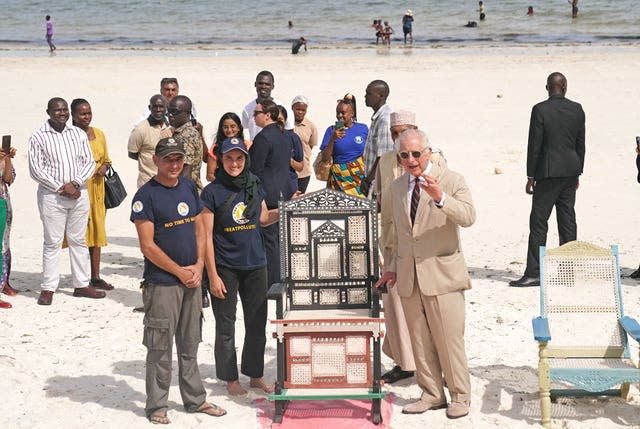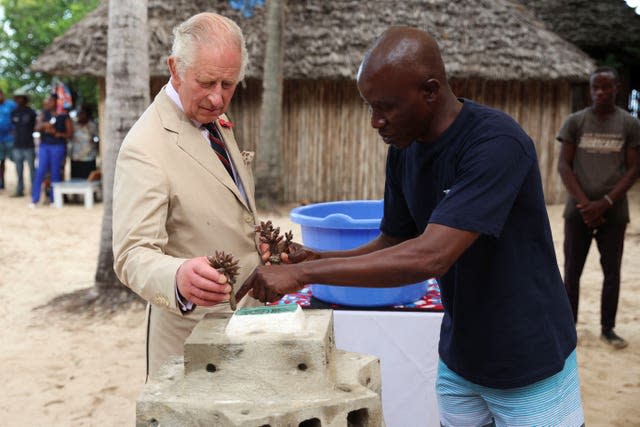King reminisces about taking on infamous Royal Marines ‘sheep dip’

The King has reminisced about taking on the infamous Royal Marines “sheep dip” exercise obstacle when he watched Kenyan Marines being put through their paces.
The marines, who are being trained by the Royal Marines and US Marine Corps, are part of a five-year programme to create a marine corps which can help combat the al Qaida-inspired al-Shabab on the Somali border.
The King and Queen watched as 18 Kenyan Marines in inflatable boats landed on a beach at Mtongwe Naval Base near Mombasa and laid down a barrage of fire – blanks only – from their M4 carbines after coming under attack from a defensive position on the beach.
A 10-strong specialist training team from the Royal Marines’ 40 Commando put 26 Kenyan Marines through 12 weeks of intensive training, and the first cohort of the newly created Kenyan Marine Commando Unit (KMCU) completed the course on May 5.
The aim is for the KMCU to become an elite fighting force that can conduct specialised amphibious operations to weaken and disrupt threats in the region.
For the King, who wore his Royal Marines tie in his role as their Captain General, the exercise brought back memories of 1974 when as Prince of Wales he did part of the Royal Marines all arms course in Lympstone while qualifying as a helicopter pilot with the Royal Navy.
Captain Sam Powell, of 40 Commando, who spoke to the King after the training exercise, said: “We talked about Lympstone and the all arms course.
“The King’s done part of that course before. He was reminiscing about the sheep dip, which is part of the endurance course.

“It is essentially a submerged tunnel that you dive through and underneath and then come out the other side. So you have to hold your breath as you go underneath it.”
After the exercise Charles asked one Kenyan Marine: “Have the Royal Marines put you through quite a lot? Have they put you through an assault course? They are quite testing!”
He asked another if they had intercepted any drug smugglers, adding: “You know exactly what to do with them!”
The King also spoke to a Royal Marines instructor, saying: “When you get back do you get a nice bit of leave?”
“I hope so, sir,” he replied.

Later, the King, who has been considered an eco-warrior by some, was recognised as a “Tide Turner warrior” for his commitment to reducing plastic pollution in oceans.
Charles was presented with his Tide Turners badge during a visit to Nyali Beach in Mombasa, where he was learning about local environmental initiatives including a beach clean-up and a turtle conservation programme.
When he met a group of Girl Guides involved with Tide Turners, a global movement educating young people about plastic marine pollution, Joanne Mirraho, 17, prompted cheers from her peers when she told the King “I love you!”
The King also met Dipesh Pabari and Ali Skanda, who told him how their non-profit organisation Flipflopi had created a unique sailing dhow, made out of recycled plastic and decorated with 30,000 discarded flip flops.
They presented a traditional Swahili throne – crafted from recycled plastic – as thanks for a £700,000 grant their organisation received from the UK Government, enabling them to collect up to 15 tonnes of plastic a month and run their own recycling factory.

The King ended his day by watching as a portion of an artificial coral reef he helped to construct, decorated with an eco-friendly glass plaque bearing his cypher, was lowered on to the sea bed.
At the Kuruwitu Conservation Area, Charles learnt about the process of coral gardening, which involves fixing coral “plugs” into structures made from concrete and sand.
As he plucked pieces of coral from a bucket and fixed them into the base he asked: “How do you do this? Do you take a piece off the reef?… So presumably, all sorts of different corals will start developing on this structure? It’s extraordinary.”


